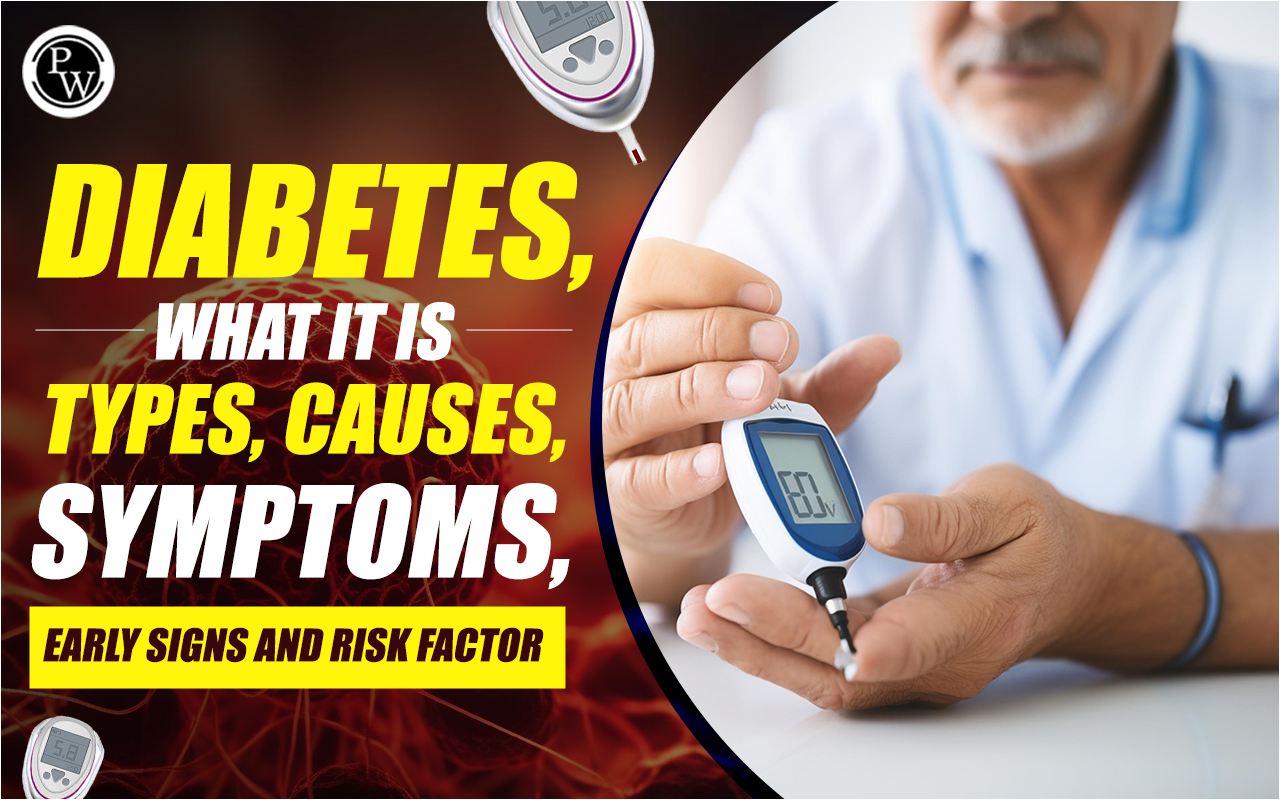

Diabetes: Diabetes, a prevalent condition that impacts individuals across age groups, manifests in various forms, with Type 2 being the most widespread. Effectively managing this condition and preventing complications is achievable through a blend of treatment approaches. Diabetes arises when your blood sugar levels soar, a result of either insufficient insulin production by the pancreas or ineffective utilization by the body.
- In the United States, approximately 34.2 million people of all ages are living with diagnosed and undiagnosed diabetes.
- Without consistent and careful management, diabetes can result in an accumulation of sugars in the bloodstream, elevating the risk of severe complications such as stroke and heart disease.
- Diabetes comes in various forms, and how individuals handle the condition varies depending on the type. It's important to note that not all types of diabetes are linked to being overweight or leading a sedentary lifestyle; some forms may be present since childhood.
- The most prevalent types of diabetes are type 1, type 2, and gestational diabetes, which we'll delve into more detail shortly. Additionally, there are less common types such as monogenic diabetes and cystic fibrosis-related diabetes.
Diabetes, What Is It?
Diabetes occurs when the level of sugar (glucose) in your blood becomes excessively elevated. This happens when your pancreas either produces insufficient insulin or none at all, or when your body fails to respond effectively to the effects of insulin. Diabetes is a condition that can affect individuals of all age groups. The majority of diabetes cases are chronic and require ongoing management through medications and/or lifestyle adjustments. Your primary source of glucose (sugar) is derived from carbohydrates in your food and beverages. This glucose serves as the main energy source for your body, transported by your blood to fuel all your cells. For glucose to reach its destination in your bloodstream, it needs assistance—an "unlocking key," so to speak. This key is insulin, a hormone. If your pancreas is not producing enough insulin or if your body is not utilizing it properly, glucose accumulates in your bloodstream, leading to elevated blood sugar levels, known as hyperglycemia. Consistently high blood glucose levels can contribute to various health issues over time, including heart disease, nerve damage, and vision problems.Diabetes Mellitus
Diabetes mellitus goes by the technical name "diabetes." It's worth noting that another condition, diabetes insipidus, also carries the name "diabetes," but the two are distinct. Despite the shared name, they cause increased thirst and frequent urination. It's important to recognize that diabetes insipidus is considerably rarer compared to diabetes mellitus.Diabetes Types
Diverse types of diabetes exist, and among them are the following common forms:- Type 2 diabetes: This type arises when your body falls short in insulin production and/or your body's cells don't respond adequately to insulin (a condition known as insulin resistance). It's the most prevalent form, impacting adults primarily but also found in children.
- Prediabetes: Considered a precursor to Type 2 diabetes, prediabetes signifies elevated blood glucose levels that haven't reached the official diagnosis threshold for Type 2 diabetes.
- Type 1 diabetes: Characterized as an autoimmune disease, Type 1 diabetes involves the immune system attacking and destroying insulin-producing cells in the pancreas for reasons yet unknown. While it's typically diagnosed in children and young adults, it can manifest at any age.
- Gestational diabetes: This type surfaces during pregnancy in certain individuals. Although gestational diabetes typically resolves post-pregnancy, those affected face a heightened risk of developing Type 2 diabetes later in life.
Diabetes Causes
Diabetes, irrespective of its type, is marked by an excess of glucose circulating in your bloodstream. However, the reasons behind elevated blood glucose levels vary depending on the specific type of diabetes. The causes of diabetes encompass:- Insulin Resistance: The primary culprit behind Type 2 diabetes is insulin resistance. This occurs when cells in your muscles, fat, and liver fail to respond appropriately to insulin. A range of factors, including obesity, sedentary lifestyle, dietary choices, hormonal imbalances, genetics, and certain medications, contribute to varying degrees of insulin resistance.
- Autoimmune Disease: Type 1 diabetes and LADA (Latent Autoimmune Diabetes in Adults) manifest when your immune system launches an attack on the insulin-producing cells in your pancreas.
- Hormonal Imbalances: Pregnancy triggers the release of hormones from the placenta, inducing insulin resistance. Gestational diabetes may develop if your pancreas can't generate sufficient insulin to counteract this resistance. Other conditions linked to hormonal imbalances, such as acromegaly and Cushing syndrome, can also lead to Type 2 diabetes.
- Pancreatic Damage: Physical harm to your pancreas, resulting from a condition, surgery, or injury, can impede its insulin production, giving rise to Type 3c diabetes.
- Genetic Mutations: Specific genetic mutations are implicated in MODY (Maturity-Onset Diabetes of the Young) and neonatal diabetes.
Diabetes Symptom
- Increased Thirst (Polydipsia) and Dry Mouth.
- Frequent Urination.
- Fatigue.
- Blurred Vision.
- Unexplained Weight Loss.
- Numbness or Tingling in Hands or Feet.
- Slow-healing Sores or Cuts.
- Frequent Skin and/or Vaginal Yeast Infections.
Additional details about symptoms per type of diabetes include:
- Type 1 Diabetes: Symptoms of T1D can manifest swiftly—over a span of weeks or months. Additional symptoms may emerge, indicating a severe complication known as diabetes-related ketoacidosis (DKA). DKA is a critical condition necessitating immediate medical attention and is characterized by symptoms such as vomiting, stomach pains, breath with a fruity aroma, and labored breathing.
- Type 2 Diabetes and Prediabetes: Symptoms for Type 2 diabetes and prediabetes may be subtle or even absent, as they tend to develop gradually. Elevated blood sugar levels, detectable through routine bloodwork, might precede noticeable symptoms. An additional potential indicator of prediabetes is the presence of darkened skin in specific areas (acanthosis nigricans).
- Gestational Diabetes: Symptoms of gestational diabetes typically go unnoticed. Screening for gestational diabetes usually occurs between the 24th and 28th weeks of pregnancy, conducted by your healthcare provider.
How common is diabetes?
Diabetes is a prevalent condition, affecting around 37.3 million individuals in the United States, approximately 11% of the population. The most widespread form is Type 2 diabetes, encompassing 90% to 95% of all diabetes cases. Globally, about 537 million adults grapple with diabetes, a number projected to escalate to 643 million by 2030 and reach 783 million by 2045, according to expert predictions.Diabetes Early Signs
- Toilet - going for a wee a lot, especially at night.
- Thirsty - being really thirsty.
- Tired - feeling more tired than usual.
- Thinner - losing weight without trying to.
- Genital itching or thrush.
- Cuts and wounds take longer to heal.
- Blurred eyesight
- Increased hunger.
Diabetes Risk Factor
Type 1 Diabetes: If you're a child or teenager, have a parent or sibling with the condition, or carry specific genes associated with the disease, your likelihood of developing type 1 diabetes increases.
Type 2 Diabetes: Risk factors for type 2 diabetes include being overweight, aged 45 or older, having a family history of the condition, lack of physical activity, a history of gestational diabetes, prediabetes, and elevated levels of high blood pressure, high cholesterol, or high triglycerides. Additionally, certain racial and ethnic populations, such as African American, Hispanic or Latino American, and Asian American adults, are disproportionately affected.
Type 1.5 Diabetes: Found in adults over 30, type 1.5 diabetes is often misidentified as type 2. Unlike type 2, individuals with this condition are not necessarily overweight, and traditional treatments like oral medications and lifestyle changes may have no effect.
Gestational Diabetes: Risk factors for gestational diabetes include being overweight, over the age of 25, a history of gestational diabetes in a previous pregnancy, giving birth to a baby weighing more than 9 pounds, a family history of type 2 diabetes, and the presence of polycystic ovary syndrome (PCOS).
Diabetes FAQs
What is diabetes?
What are the types of diabetes?
What are the symptoms of diabetes?
What causes diabetes?
How is diabetes diagnosed?












